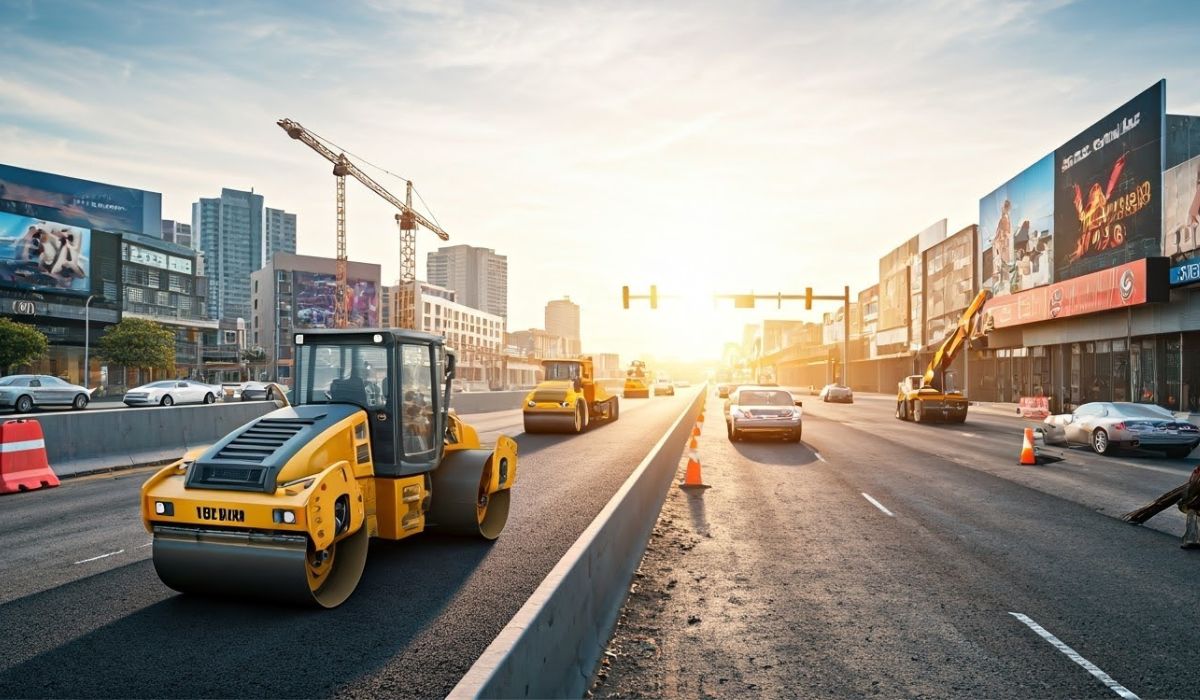Union Minister Nitin Gadkari has officially confirmed plans for the development of a direct Nagpur-Vijayawada Expressway, a major infrastructure project aimed at significantly improving connectivity between central India and the eastern coast of Andhra Pradesh. Once completed, this Rs 14,500 crore high-speed corridor will offer a direct and faster road link from Nagpur to Andhra Pradesh’s major ports, enabling seamless logistics movement, boosting exports, and stimulating regional economic growth. high-speed corridor will provide a direct link from Nagpur to Andhra Pradesh’s strategically important eastern ports, boosting trade, logistics efficiency, and regional economic growth. This ambitious expressway will become the third high-capacity road network originating from Nagpur, further strengthening the city’s position as a crucial transportation hub in India. It will join the operational Nagpur-Mumbai Samruddhi Mahamarg, which connects Nagpur to Maharashtra’s financial capital, and the Nagpur-Goa Shaktipeeth Expressway, which is currently under construction and will provide a fast, seamless route to the Konkan coast.
See also: Samruddhi Mahamarg: Revised toll, project status, route map
By opening up a direct route to Andhra Pradesh’s ports, the Nagpur–Vijayawada Expressway is expected to not only reduce travel time but also facilitate faster movement of goods between inland industrial centers and coastal trade gateways, paving the way for enhanced economic integration across states.
Key facts related to the Nagpur-Vijayawada expressway
| Implementing agency | National Highways Authority of India (NHAI) |
| Estimated cost | Rs 14,500 crore |
| State covered | Maharashtra, Telangana, Andhra Pradesh |
| Status | Under-construction |
| Length
|
405 km
|
| Expected operations from | 2026/2027 |
| Starting point | Butibori, an industrial hub located about 25 km southwest of Nagpur, Maharashtra. |
| End point | near Chilakaluripet in Guntur district, Andhra Pradesh, |
| Travel time reduced to | 7-8 hours |
| Speed | 100-120 km/h |
| No. of lanes | 4 lanes |
See also: Shaktipeeth Expressway: All about Nagpur-Goa Expressway
Route map of the Nagpur-Vijayawada expressway

What purpose would the Nagpur-Vijayawada expressway serve?
The Nagpur–Vijayawada Expressway is being developed to improve trade efficiency, reduce travel and logistics time, and cut fuel and freight costs for exporters and industries. It is part of the Bharatmala Pariyojana, which focuses on developing high-speed corridors across India. Other important benefits from this project include:
Strategic lift from access to eastern ports
- Andhra Pradesh has 12 developing ports and exporters from Vidarbha will gain faster, cheaper access to global markets. Gadkari’s target is to reduce India’s logistics cost to 9% by December 2025, lower than the US and EU averages.
- The Rs. 37,000-crore Raipur–Vizag corridor, now 88% complete, will enhance links between Vidarbha’s steel sector and key coastal shipping hubs. Meanwhile, the Raipur–Hyderabad Expressway will further boost freight and passenger connectivity between central and southern India.
Investments in tourism, defence and industries
- Plans are also in motion to establish a dedicated defence manufacturing cluster in Nagpur, positioning the city as a significant hub for India’s strategic and industrial capabilities. This initiative aims to attract major defence sector investments, promote indigenous manufacturing under the ‘Make in India’ program, and create employment opportunities in high-tech engineering and allied services.
- Additionally, a proposal has been put forward to develop an airstrip at Ambhora in Kuhi tehsil, a scenic location where five rivers converge. This unique confluence, already earmarked for tourism promotion, is envisioned as a dual-purpose site, serving both as a regional aviation facility to improve connectivity and as a tourist attraction showcasing natural beauty, water-based recreation, and cultural heritage. Together, these projects are expected to bolster Nagpur’s profile as both an economic powerhouse and a destination for leisure and investment.
Route alignment of the Nagpur-Vijayawada expressway
The 405 km long expressway will traverse three states, namely, Maharashtra, Telangana, and Andhra Pradesh, passing through several industrial and commercial centers.
Proposed Route Alignment:
Nagpur → Wardha → Chandrapur → Komaram Bheem Asifabad → Mancherial → Peddapalli → Jayashankar Bhupalpally → Hanumakonda → Warangal → Mahabubabad → Khammam → Krishna (Vijayawada)
This strategically planned route will provide direct access to major industrial clusters, reduce congestion on existing highways like NH-44 and NH-65, and promote balanced regional development.
Travel time between the two destinations
For the Nagpur-Vijayawada Expressway, the travel time between the two cities is expected to drop from the current 14-15 hours to roughly 7- 8 hours once the highway is operational. This is due to the expressway’s shorter route, access-controlled design, and higher permissible speeds of up to 120 km/h.
Real estate impact of the Nagpur-Vijayawada expressway
The Nagpur-Vijayawada Expressway is expected to boost real estate development in the areas it connects, including Maharashtra, Telangana and Andhra Pradesh. With reduced travel time, improved connectivity and increased commercial activity being major benefits of the new to-be launched project, demand for both residential and commercial properties along the expressway route would be raised significantly. Let us look at other benefits and perks the real estate industry may face due to the execution of the new project:
- Increased property values:
The expressway is likely to lead to a rise in property prices and land value due to improved accessibility and connectivity. - Residential and commercial development:
Increased demand for housing and commercial spaces, particularly near access points and industrial areas, is expected. - Industrial and warehousing growth:
Better connectivity will likely attract industries and warehousing companies, further boosting real estate development. - Tourism and hospitality:
Reduced travel time between major cities will likely benefit the tourism and hospitality sectors, potentially driving demand for hotels and related businesses. - Affordable housing:
Peripheral areas along the expressway may see development of affordable housing projects to cater to the needs of those working in the connected cities.
As per Housing.com , following are the approximate property costs when you are looking at buying or renting in some of the hotspots in the Nagpur- Vijayawada expressway:
| Location | Average price for buying | Price range per sqft for buying | Average rent | Price range (rent) |
|---|---|---|---|---|
| Warangal | Rs 5,129 per sqft | Rs 2,869- Rs 11,250 | Rs 6,625 | Rs 4,500- Rs 11,000 |
| Wardha | Rs 3,704 per sqft | Rs 247 – Rs 12,666 | Rs 13, 5000 | Rs 7,000 – Rs 23,000 |
| Chandrapur | Rs 3,496 per sqft | Rs 1,263- Rs 11,058 | Rs 11,090 | Rs 3,000 – Rs 21,000 |
| Mancherial
|
Rs 5,180 per sqft | Rs 1,750- Rs 13,333 | Rs 33,166 | Rs 5,000- Rs 85,000 |
| Peddapalli | Rs 4,186 per sqft | Rs 3,393 – Rs 4,979 | Rs 20,000 | Rs 10,000- Rs 30,000 |
Source: Housing.com
Speed limit on the Nagpur-Vijayawada expressway
The Nagpur-Vijayawada Expressway has a maximum speed limit of 120 km/h for cars and light vehicles while for the larger passenger vehicles and goods vehicles, the limit stays at 90km/h and 80 km/h respectively.
What is the project cost for this venture?
The estimated cost for the 405 km long, 4-lane Nagpur-Vijayawada Expressway is Rs.14,500 crore.
Toll charges for the Nagpur-Vijayawada expressway
The toll charges for the Nagpur-Vijayawada Economic Corridor have not been officially announced yet. However, given its scale as a major highway project, toll collection is expected once it becomes operational. The National Highways Authority of India (NHAI) will set the rates, considering factors like construction and maintenance costs, travel distance, vehicle type, and government guidelines. Charges may vary across different sections, particularly where complex infrastructure such as bridges or tunnels is involved. Once finalized, the toll structure will be publicly notified, ensuring transparency for commuters and freight operators, enabling them to plan travel and logistics efficiently along the corridor.
What was used before the construction of Nagpur-Vijayawada expressway?
Before the Nagpur-Vijayawada Expressway project began, travel between the two cities primarily relied on a combination of existing National Highways. The main route typically involved taking National Highway 44 (NH44) and then connecting to other roads, such as National Highway 65 (NH65).
In contrast, the upcoming Nagpur-Vijayawada Expressway is a greenfield project, meaning it is being constructed on an entirely new alignment rather than by upgrading existing roads. This modern corridor is expected to drastically cut travel time and enhance connectivity, providing a more efficient link between central India and the strategically important eastern ports.
Housing.com POV
The Nagpur–Vijayawada Expressway represents a transformational step in India’s highway infrastructure, connecting Maharashtra, Telangana, and Andhra Pradesh through a state-of-the-art, high-speed corridor. By slashing travel time from 14-15 hours to just 7-8 hours, it will enable faster movement of goods, reduce logistics costs, and open up direct access to Andhra Pradesh’s eastern ports, which is an advantage for exporters and industries in central India. Beyond transportation, the expressway is set to catalyse tourism, industrial development, real estate growth, and defence manufacturing, further solidifying Nagpur’s position as a key economic hub. With a cost of Rs.14,500 crore and completion targeted by 2026–27, this project promises to be a vital link in India’s push for modern, efficient, and integrated transport infrastructure.
FAQs
What is the length and expected completion date of the Nagpur–Vijayawada Expressway?
The expressway will be 405 km long and is expected to be operational by 2026–27.
How much will the Nagpur–Vijayawada Expressway cost to build?
The project is estimated to cost Rs. 14,500 crore, developed under the National Highways Authority of India (NHAI).
How much travel time will the expressway save?
Once complete, travel time between Nagpur and Vijayawada will reduce from 14–15 hours to around 7–8 hours.
| Got any questions or point of view on our article? We would love to hear from you. Write to our Editor-in-Chief Jhumur Ghosh at jhumur.ghosh1@housing.com |







